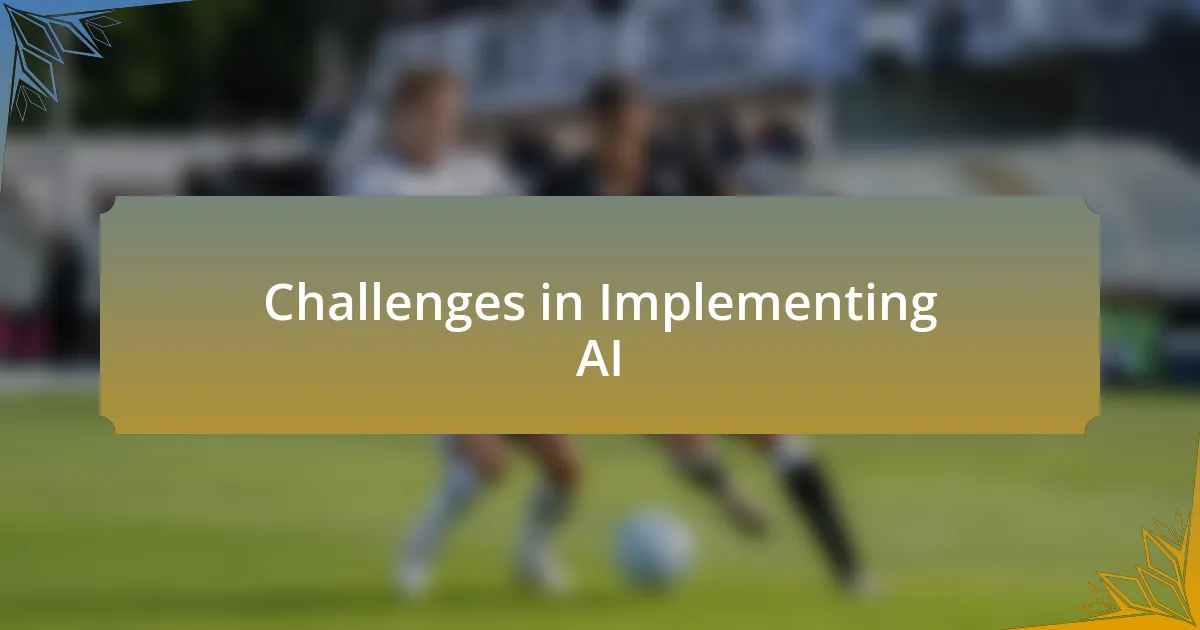Key takeaways:
- AI enhances customer service by improving efficiency, but maintaining emotional connections is crucial.
- Successful AI integration requires clear communication, team involvement, and setting realistic milestones.
- Addressing team skepticism and fostering adaptability are vital for embracing AI-driven changes.
- Data analytics play a key role in refining AI strategies and understanding customer needs.

Understanding AI in Customer Service
Understanding AI in customer service can feel like stepping into a new world, filled with possibilities. I remember my first encounter with a chatbot designed to help customers 24/7. It was fascinating to see how it quickly responded to inquiries, yet I couldn’t shake the feeling of missing the warmth of a human touch. How do we maintain empathy in a realm that often feels mechanical?
AI operates on vast amounts of data, allowing it to predict customer needs and enhance experiences like never before. However, I’ve sometimes found that these algorithms can miss the nuances of human emotions. Have you ever felt frustrated when a system fails to grasp the context of your problem? I certainly have.
The true challenge lies in finding a balance between efficiency and emotional intelligence. I have learned from my experience that integrating AI isn’t just about technology; it’s about reshaping our approach to customer interactions. What if we could leverage AI to enhance human connection instead of replacing it? That’s a question worth pondering as we navigate this evolving landscape.

The Role of AI Today
AI plays a transformative role in customer service today, acting as a powerful tool that enhances both efficiency and effectiveness. I remember a time when handling customer inquiries was an overwhelming task, often leaving me feeling swamped. With AI’s introduction, those same inquiries are now processed swiftly, allowing me to focus on more complex customer interactions. Isn’t it incredible how technology can take on the mundane tasks and free us to build deeper relationships?
One of the most striking aspects of AI is its ability to analyze data patterns in real time. I’ve had the chance to witness how predictive algorithms help businesses anticipate customer needs before they even express them. Reflecting on my own experiences as a customer, I have often marveled at times when recommendations felt almost like mind reading. But it raises a question: can machines really understand the personal context behind a customer’s request, or do they simply rely on statistics?
Despite its advantages, the reliance on AI also prompts me to ponder the potential loss of human touch. I’ll never forget a moment when a customer expressed appreciation for a genuine conversation that a chatbot could never replicate. It reminds me that while AI can handle the basics, our emotional connections with customers remain irreplaceable. It’s a delicate dance between technology and humanity, and I believe finding that balance is key to crafting memorable customer experiences.

Challenges in Implementing AI
Implementing AI in customer service comes with its own set of unique challenges. One major issue I encountered was the initial resistance from my team. It was disheartening to watch colleagues hesitate to embrace AI, fearing it might replace their roles rather than enhance their capabilities. Have you ever faced a situation where fear of change overshadowed the potential benefits? It’s a common struggle, but navigating that resistance is essential for a smooth transition.
Another hurdle I experienced was ensuring data accuracy before AI could effectively operate. When integrating AI systems, I found myself knee-deep in cleaning and organizing customer data, a task that felt tedious yet vital. In my experience, overlooking this step can lead to unsatisfactory customer interactions. It’s a sobering reminder that technology isn’t a magic fix; it requires a solid foundation to truly thrive.
There’s also the challenge of maintaining the human element amid AI’s rise. I recall a time when a customer expressed frustration with an automated response that completely missed the mark on their inquiry. It made me realize that while AI can process information rapidly, crafting responses that resonate emotionally still requires a human touch. How do we strike a balance between efficiency and empathy? It’s an ongoing journey that requires constant reflection and adaptation.

My Journey with AI Adoption
As I began integrating AI into our customer service operations, I quickly recognized the importance of establishing clear communication with my team about the benefits it could bring. I remember one team meeting where I shared a success story of how AI helped another company streamline their support process, leading to happier customers and more time for staff to focus on complex issues. It sparked a discussion about our potential, and seeing that spark of interest rather than fear was a turning point for me.
Adapting to AI also pushed me to rethink how I approached training. I introduced hands-on workshops where team members could engage with AI tools in real-time, which initially felt daunting. However, witnessing my colleagues’ faces light up as they started to grasp the technology was exhilarating. It reminded me that, while the journey may be filled with learning curves, those moments of realization are what foster growth and adaptation.
Reflecting on my journey, I often ponder whether we, as a society, are truly ready for the integration of AI. I’ve experienced firsthand the blend of excitement and apprehension as my team grapples with these changes. Have you ever felt that tingling mix of anticipation and apprehension when embarking on something new? Each step we’ve taken toward embracing AI has led to pivotal lessons about resilience and innovation that I will carry with me as we move forward.

Strategies for Successful Integration
When it came to integrating AI into our customer service strategy, one key approach was involving the team from the outset. I organized brainstorming sessions where everyone could voice their concerns and ideas about how AI tools could enhance our workflow. It was during one of these sessions that a junior team member suggested using AI to automate routine inquiries, freeing us up for more complex customer interactions. This idea not only propelled our integration efforts but also fostered a sense of ownership among the team.
Another effective strategy I found was to set realistic milestones for implementation. Initially, I aimed for small wins that could be celebrated, like successfully automating a basic FAQ function. Each time we achieved a goal, it was a morale booster, reinforcing the message that we were making tangible progress. How often do we overlook the value of celebrating the small victories? Personally, I cherish those moments when the team’s enthusiasm peaks, reminding me that patience and persistence lead to success.
Training and continuous learning proved invaluable as well. We established regular check-ins to discuss the challenges we faced with AI integration. One memorable session involved troubleshooting a recurring issue with our AI chatbots; the collective problem-solving energy in the room was electric. I realized then that fostering a culture of collaboration not only accelerated our adaptation to AI but also created a supportive environment where everyone felt valued. Have you considered how collaboration can smoothen your own integration challenges?

Lessons Learned from AI Experiences
Embracing AI brought with it a learning curve that I hadn’t anticipated. Early on, I encountered skepticism from team members worried that AI would replace their roles. I remember one day, during a team meeting, I encouraged everyone to voice their fears. This open dialogue transformed apprehension into curiosity, highlighting the importance of addressing emotions head-on. Have you ever considered how a simple conversation can reshape perspectives?
Another important lesson was the necessity for flexibility in our approach. I vividly recall a time when we rolled out a new AI feature that didn’t perform as expected. Instead of viewing it as a failure, I encouraged the team to see it as a step in our learning journey. We gathered feedback, adjusted our strategy, and reimplemented the feature with improved functionality. This experience taught me that adaptability can turn setbacks into opportunities for growth. How have you adapted when faced with unexpected challenges?
Lastly, I discovered the undeniable value of data analytics in refining our AI strategies. Analyzing user interactions revealed patterns that we hadn’t noticed before. I was amazed by how these insights guided our efforts, allowing us to tailor our services more effectively. During one review session, I could see the spark in my team’s eyes as they connected the dots between data and real-world customer experiences. It made me wonder—how often do we overlook the insights hidden in our data?